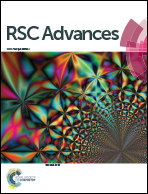A colorimetric and “turn-on” fluorimetric chemosensor for the selective detection of cyanide and its application in food samples†
Abstract
A novel highly selective isonicotiamide-based chemosensor HY for cyanide was successfully designed and synthesized, which showed both colorimetric and fluorescent turn-on responses for cyanide ions in aqueous. This structurally simple chemosensor could detect CN− anion over other anions in aqueous solution DMSO/H2O (v/v = 7 : 3) undergo deprotonation reaction. Results showed that the chemosensor HY exhibited 14-fold enhancement in fluorescence at 552 nm and showed yellow fluorescence under the UV-lamp after the addition of CN− in aqueous solution. An obvious change in color from pale yellow to yellow that could be detected by naked eye. We have successfully utilized the above CN− and H+ for the fabrication of INHIBIT molecular logic gates, using CN− and H+ as chemical inputs and the fluorescence intensity signal as the output. Moreover, the detection limit on fluorescence response of the sensor to CN− is down to 5.12 × 10−8 M by titration method. Test strips based on HY were obtained, which could be used as a convenient and efficient CN− test kit to detect CN− in aqueous solution. Furthermore, the sensor could detect the CN− in food sample as a sample and effective method.


 Please wait while we load your content...
Please wait while we load your content...